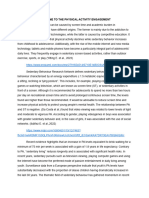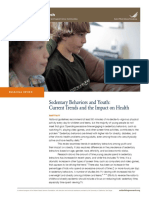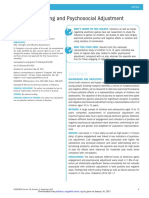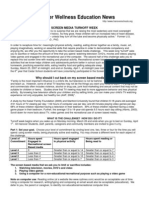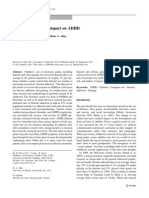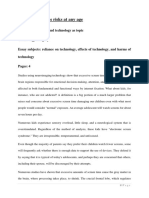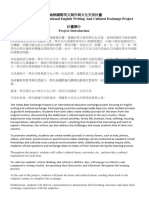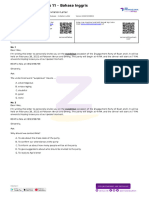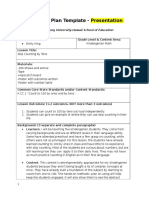Psychiatr Q
DOI 10.1007/s11126-016-9486-3
O R I G I N A L PA P E R
Everything in Moderation: Moderate Use of Screens
Unassociated with Child Behavior Problems
Christopher J. Ferguson 1
# Springer Science+Business Media New York 2017
Abstract The impact of children’s use of Bscreen^ media including television and computer
games, continues to be debated. The American Academy of Pediatrics (AAP) until recently
recommended a relatively restrictive screen time diet of 2 h or less for most youth. A
representative correlational sample of youth were assessed for links between screen time and
risky behavioral outcomes. Data collection occurred in 2013 conducted by the State of Florida.
Use of screens that was moderately high, in excess of the AAP’s former recommendations, but
not excessive (1 SD or higher than average), was not associated with delinquency, risky
behaviors, sexual behaviors, substance abuse, reduced grades or mental health problems. Even
excessive screen use (1 SD or higher) was only weakly associated with negative outcomes
related to delinquency, grades and depression only, and at levels unlikely to be practically
significant. Results conceptually replicate those of Przybylski (2014) with a US sample for
depression and delinquency as outcomes. Moderate use of screens, though in excess of the
AAP’s historical recommendations, are unassociated with problem outcomes. Excessive use of
screens is only weakly associated with negative outcomes, and only those related to depression
and delinquency as well as reduced grades, but not risky driving, substance use, risky sex or
disordered eating. Although an Beverything in moderation^ message when discussing screen
time with parents may be most productive, results do not support a strong focus on screen time
as a preventative measure for youth problem behaviors.
Keywords Video games . Television . Screen time . Adolescents . Risk behaviors
Introduction
Screen technology, ranging from televisions to computers to smart phones have become
increasingly integrated into the lives of youth (minors age 12–18). Considering all screens
* Christopher J. Ferguson
CJFerguson1111@aol.com
1
Department of Psychology, Stetson University, 421 N. Woodland Blvd, DeLand, FL 32729, USA
� Psychiatr Q
together, it is estimated that screen time among youth averages approximately 7–8 h per
day [1]. Organizations such as the American Academy of Pediatrics typically advocate
for far fewer screen hours for youth, typically around 2 h a day. However, with screens
becoming increasingly integrated into education, work, communication and socialization,
rather than just passive entertainment, the applicability of such guidelines has become
less clear. For instance, with younger children, the organization Zero-to-Three has noted
that how screens are used is often more critical than simply focusing on number of hours
[2]. Nonetheless, concerns persist regarding the potential impact of excessive screen time
(defined here as 1 SD above mean use) on youth behavioral outcomes.
Relationships between screen time and behavioral outcomes have not always been
clear. Although most scholars would likely agree that screen time should be balanced
with other activities and excessive use avoided, disagreement exists on the importance
of screen time as a predictor of behavioral issues. Evidence on outcomes is often
mixed, with suggestions of complexity in the interaction between screens and behavior.
For example, screen time is associated with obesity, but only to the extent it interferes
with physical activity. If recommendations for physical activity are met, screen time,
even if considerable, no longer predicts obesity [3]. Likewise, evidence suggests that
links between screen time and cognitive performance are complex, often relating to
quality more than quantity [4], without clear evidence that screen time exposure relates
to test scores [5].
Regarding behavioral issues, research has had difficulty observing linear consistent linear
relationships between screen time and outcomes such as criminal aggression [6], disordered
eating [7], and depression [8]. One possibility is that screen time influences may not be linear
at all but may instead be dose dependent. That is to say that screen time consumption that is
within the average range may be developmentally normal, with only excessive use compared
to peers being indicative of potential problems. This approach differs from the historically typ-
ical screen time recommendations with absolute time cut-offs, above which use may be
considered to be problematic no matter how normative.
Several recent studies have indicated support for the dose-dependent explanation for
links between screen time and problem outcomes. Przybylski [9] examined the relation-
ship between time spent playing video games and externalizing and internalizing symp-
toms in a large sample of children from the UK. Light users of video games were found
to have the fewest symptoms, with non-users and moderate users (those with 1 SD of
mean use) also relatively low in symptoms. Heavy use of video games was associated
with more externalizing and internalizing symptoms, although Przybylski observed that,
even for heavy users, the relationship between video game time and behavioral outcomes
was very small, potentially lacking practical significance. Such dose dependent effects
have been found in other studies, often indicating worse results for both heavy users and
non-users of video games [10, 11].
Few studies have examined this issue for screen time more generally nor with a
wider array of behavioral outcomes. As such this study will examine dose-dependent
influences of screen time on a range of behavioral outcomes including depressive
symptoms, delinquency, risky driving, substance abuse, risky sex, disordered eating
and GPA (Grade Point Aveage). It is hypothesized in each case that excessive (1 SD
above the mean), but not moderate (within 1 SD of the mean) or light screen time
will be associated with negative behavioral outcomes despite other relevant factors
being controlled.
�Psychiatr Q
Methods
Participants
Participants in the current study were a representative sample of 6089 youth from the state of
Florida. Participants were part of the 2013 Youth Risk Behavior Survey which is coordinated
by the Centers for Disease Control. Participants were almost equally distributed in terms of sex
(50.9% were female). Regarding race, the largest percentage of youth were Caucasian (43.7%)
with smaller amounts of African-American (22.8%), Native American (0.4%), Hispanic
(27.7%) Asian (2.0%) or other groups (3.4%). The average age of our sample was 16 (range
12–18, SD = 1.24).
Materials
Data in the current study were drawn from the Florida version of the Youth Risk Behavior
Surveillance System’s school-based Youth Risk Behavior Survey (YRBS). Description of the
development and validation of the YRBS can be found from the CDC [12]. This survey
instrument included several scales of interest to the present study. In many cases scale metrics
differed between questions. As such all answers were first converted to z-scores prior to
summation into scale scores. Reported coefficient alphas are for the current sample. These
included the following:
Risk/Protective Factor Variables
Sleep A single item Bon an average school night, how many hours of sleep do your get?^ was
included to measure sleep quality of youth. This variable can indicate overall stress, and
quality of rest which can influence mental health.
Physical Activity Three items measuring overall physical activity, participation in PE
(physical education) and participation in sports (alpha = .53) were included as a measure of
physical activity. Physical activity for youth is normative and developmentally healthy and
time spent on physical activity takes time away from risky behaviors.
Family Involvement Family involvement was measured by a single item inquiring as to the
frequency of the youth’s family eating dinner together. This was included as a general indicator
of family cohesiveness.
Depression This scale consisted of three items related to depressive symptoms. BDuring the
past 12 months, did you ever feel so sad or hopeless almost every day for two weeks or more
in a row that you stopped doing some usual activities?^ is an example item. Coefficient alpha
was .72. Depression is used both as an outcome on its own, as well a risk factor for other
outcomes, as previous research has indicated that risk taking behaviors are more common with
children experiencing depression [13].
Screen Time Two items measured frequency of television and video game screen time. BOn
an average school day, how many hours do you watch TV^ is an example item. These were
summed together to form a measure of total media viewing time.
� Psychiatr Q
Outcome Variables
Depression As noted above, depression was included as an outcome variable in its own right
as well as a risk factor for other outcomes.
Delinquency Four items were used to measure delinquency. These concerned themselves
with issues of weapons carrying, fighting off and on school property, and being injured in a
physical fight. Alpha reliability was .76
Risky Driving Three items concerned themselves with risky driving behaviors (alpha = .68).
These items involved driving and drinking, riding in a car while the driver had been drinking
and texting while driving. A fourth item planned for inclusion in the preregistration (as noted
below, the study was preregistered) regarding seat belt use was dropped due to low reliability
with the other items.
Illegal Substance Use This eleven item scale measured the frequency of use of multiple
forms of illegal drugs (from marijuana to Bhard^ drugs such as cocaine and heroin).
Coefficient alpha was .91.
Risky Sexual Behaviors This five item scale (alpha = .89) examined risky sexual behaviors
the youth engaged in. These included lifetime and recent sexual partners, condom use, sex
while intoxicated and pregnancy.
Disordered Eating Disordered eating was assessed via a three item scale (alpha = .58). Items
involved purposeful weight loss using fasting, pills or vomiting. An initial plan to include
healthy eating as an outcome in the preregistration was not included, to maintain focus on risky
behaviors. Note that this outcome was not assessed prior to making this decision.
Grades (GPA) Students were asked to provide their grades using a single item.
Procedure
Participation in the current study was achieved through two-step cluster probability sampling.
First, schools in Florida were randomly selected for participation, then classroom within those
schools were randomly selected for participation. All students in the selective classrooms were
invited to participate. This procedure was designed to produce a sample representative of youth
attending schools in the state of Florida. Passive parental consent was used for all youth in grades
9 through 12, and children assented to the procedure. All procedures were designed to meet
federal standards for ethical research with human participants. Although the data is archival a data
and analysis plan was preregistered prior to analysis and is available at: https://osf.io/7xm3j/
Results
All results were analyzed using OLS (ordinary least squares) regression using SPSS
software. Predictor variables were entered first into the equation, followed by screen time
�Psychiatr Q
contrasts. Consistent with Przybylski [9] screen time contrasts were developed to exam-
ine for potential dosing effects. These consisted of four groups. First were abstainers,
those youth who reported no screen time whatsoever. Low users were those youth who
fit more closely with the standard guidelines of no more than 2 h a day of screen time.
Moderate users included those users within a standard deviation of the mean on screen
time. Moderate users would correspond to roughly three to six hours of use each day.
Excessive users included all users at least one standard deviation above the mean on
screen time. Contrasts were dummy coded, with abstainers used as the reference cate-
gory. Collinearity diagnostics revealed an absence of issues related to multicollinearity in
the current analysis, with VIFs typically no higher than 1.12.
All results are presented in Table 1. Across most outcomes male gender and depression
were significant risk factors for worse outcomes, consistent with prior research. Family
involvement was a fairly consistent protective factor.
Regarding screen time, neither low to moderate use of screens was related to worse outcomes
than was media abstinence. This corresponds to the observation that up to six hours of screen time
as indicated by TV and computer game use, was not a risk factor for negative outcomes.
Excessive use was significantly related to depression, delinquency and reduced grades, but not
to other outcomes. Thus, results of Przybylski [9] are replicated here regarding depression and
delinquency, but not extended to other risky outcomes aside from grades. However, also
consistent with Przybylski, the effect sizes for outcomes related to screen time were very small,
typically accounting for less than half a percent of variance in the outcome variable (in the case of
delinquency), to just over 1% variance overlap in the case of depression. In the event of such
small effect sizes, the risk of overinterpretation of outcomes is significant. Thus, consistent with
the approach recommended by Przybylski, outcomes in this effect size range, even for excessive
screen time, suggest that screen time is not an efficient risk factor for negative outcomes.
Discussion
Screen time among children continues to be a hotly debated issue, with conflicting views
about the proper recommendations to give to children regarding screen time. At present,
Table 1 Associations between screen time, control variables and youth outcomes
Control Variables Depression Delinquency Risky Substance. Risky Sex Eating GPA
Driving Use
Male Gender -.14*** .22*** .08*** .12*** .12*** -.05 -.17***
Sleep -.16*** -.05 -.05 -.03 -.08*** -.06 .05
Physical Activity -.01 .05 .09*** .04 .07 .01 .03
Family Involvement -.10*** -.07 -.13*** -.11*** -.16*** -.13*** .07
Depression --- .15*** .09*** .17*** .12** .28*** -.06
Media Contrasts
Abst. v Low -.02 -.03 -.02 -.01 -.02 -.05 .05
Abst. v Moderate .05 -.01 -.05 -.01 -.01 -.04 -.02
Abst. v Excessive .13*** .07*** .02 .06 .06 -.03 -.11***
Effect sizes reported for control variables are for the Abstinence versus Low use contrast. However, outcomes did
not differ significant for other contrasts for control variables. All regression coefficients are standardized
***p < .001
� Psychiatr Q
a considerable gulf exists between the best known screen time recommendations provid-
ed by the American Academy of Pediatrics, and the actual screen use behaviors of youth.
More crucially, screen time recommendations often remain best guesses, with data about
the utility of such recommendations not always clear. This study sought to address gaps
on previous literature by examining what levels of screen time were associated with
negative outcomes and how strong these associations were. This data may help to guide
organizations concerned with screen time recommendations to revise those recommen-
dations in the future.
The present study conceptually replicated results of Przybylski [9] with depression and
delinquency. Specifically, relations between screen time and negative outcomes were dose
dependent, with exposures in considerable excess of the AAP’s historical 2-h maximum
recommendation required before associations with negative outcomes were noticeable.
Specifically, negative outcomes were elevated only among youth who consumed over six
hours of media a day, effectively outliers even among their peers. Further, even where these
associations were noted, they were very small, accounting only for between 0.49% of the
variance in delinquency and 1.7% of the variance in depressive symptoms. Thus it is unclear
whether such small associations warrant the degree of attention they often receive from
professional advocacy organizations. Or, put simply, a focus on screen time may not return
as much Bbang for the buck^ as some may hope.
Unexpectedly, although results of the current study conceptually replicated those of
Przybylski for delinquent and depressive, outcomes, they did not extend to most other
outcomes. Among other outcomes, screen time only negatively predicted GPA, and once
again the relationship was very small with screen time only predicting 1.2% of the
variance in grades. For other outcomes related to risky driving, risky sex, substance
abuse and restrictive eating, media was not a significant predictor with other life factors
controlled.
By contrast gender was one of the most consistent predictors of negative outcomes.
Male gender was generally predictive of most negative outcomes, with the exception of
female gender which predicted depressive symptoms. Further, family involvement was
generally successful as a protective predictor of negative outcomes. Family involvement
in children’s lives reduced their involvement in risky behaviors or other negative
outcomes.
Policy Implications
Results from the current study have several potential policy implications. First, the
current narrative on media effects among professional advocacy organizations may be
too extreme. Arguably, most media related policy statements from the AAP and similar
groups advocate for the potential for media, whether general use, or consumption of
specific content, to have strong deleterious effects. At present, however, data to support
such narratives is limited. This is not to say that professional advocacy organizations
should not emphasize moderation. However, it may be inappropriate to needlessly
frighten parents with the specter of outcomes related to violent crime, mental health
problems, serious school failure, drug and alcohol abuse or eating disorder diagnoses,
when evidence for substantial links between media use and these outcomes is fairly
limited. Policy statements may be on firmer ground when emphasizing potential,
though limited, impact on grades, obesity, or exclusion from other activities.
�Psychiatr Q
However, adopting a more moderate and measured tone may increase the credibility of
such policy statements.
Second, it is likely the case that setting hard time limits on screen use is a fraught avenue for
policy. First, data from the current study suggests that children are resilient to screen con-
sumption at much higher levels, up to six hours daily, than is typically recommended by most
policy statements. Thus, policy statements focused on restrictive media consumption may do
more to foster guilt in parents unable to meet unrealistic expectations than they do help
children. This may also apply to controversial areas of media use such as violent or sexy
media, where policy statements often advocate abstinence or substantial restriction, a media
use outcome that is unlikely to be met for most children, and for which data on efficacy are
unclear at best. An unnecessary focus on objectionable content may ultimately devolve into
moralizing rather than providing practically useful guidelines.
In addition, as noted by the group Zero to Three [2], focusing mainly on time consump-
tion ignores the issue that how media are used is often more critical than how often media are
used. Most existing media policy statements imply that media use is of limited value and, at
best, detracts from engagement in other activities involving socialization or learning.
However, this understanding of media may be unnecessarily simplistic as learning and
socialization can often occur within the context of using media. Further, screens of various
sorts are increasingly embedded into daily life, whether education, work, socialization or
personal organization. Thus, narrow limits on screen time may not keep up with the myriad
ways in which screens have become essential to modern life. Discouraging youth from
becoming intimately familiar with screen technologies may ultimately do youth more
disadvantage than advantage.
In general, professional advocacy organizations may wish to consider releasing fewer
policy statements of all types. For instance, at present, the AAP has approximately eight
active policy statements (despite such policy statements expire within 5 years) on various
media, most of which focus on potential deleterious effects. This may inadvertently foster the
impression of organizations such as the AAP as Banti-media^ particularly when such policy
statements do not disclose research that would conflict with their positions. It is unlikely that
so many policy statements focused on deleterious outcomes are particularly informative for the
general public or are in the long-term interest of groups like the AAP, to the extent they may
alienate a general public disinclined to listen to media worriers. Given that scholars argue that
it is unrealistic for pediatricians to impart the plethora of warnings and cautions advised by the
AAP to parents within the limited time available for well-visits [14], the AAP may wish to
consider retiring some of its media-based policy statements.
Limitations and Future Directions
As with most studies, the present one has limitations that reduce confidence in the ability to
draw causal connections. First and foremost is the correlational nature of the current data
which eliminate the potential for causal inferences. Secondly, the surveys were not designed
with the specific current research questions in mind. As such, constructs are developed from
preexisting pools of survey responses. Lastly, the current study draws data from only youth
respondents. Having multiple respondents would be far more desirable.
By contrast, this study has, as a strength, the fact that it was preregistered, eliminating the
potential that post-hoc data manipulation could result in spurious results. Given ongoing
controversies about the methods in much of media effects research, increasingly adoption of
� Psychiatr Q
preregistered studies and other principles of open science could be illustrative in understanding
what media effects are reliable, and which may be the product of historical cycles of societal
concern over media. Further studies would also do well to focus on issues such as time spent
on screens, or objectionable content, and more on how screen use becomes embedded in the
social fabric of families and peer networks.
Concluding Statements
Debates about screen time are unlikely to abate in the near future. Current data suggests that
screen time has limited impact on children’s well-being. Counseling moderation in screen use
is likely to result in the healthiest outcomes, while understanding that this should focus on peer
normative screen use, rather than arbitrarily low cut-offs. Further, understanding the context of
screen use and how it is embedded in the social fabric of modern life may be crucial in
reenvisioning the role of screen use in young lives. Fundamentally, to the degree society is
concerned about the well-being of youth, focusing on screen technology may be more
distraction than panacea. This should be communicated more clearly, so that societal efforts
can be refocused on issues that have more dramatic impact on young lives.
Compliance with Ethical Standards
Conflict of Interest The author has no conflicts of interest to declare and is solely responsible for the study
design, analysis and decision to submit for publication. The author received no grants, honorarium or other
funding to contribute to this report.
Human and Animal Rights All procedures performed in studies involving human participants were in
accordance with the ethical standards of the institutional and/or national research committee and with the 1964
Helsinki declaration and its later amendments or comparable ethical standards.
Informed Consent Informed consent was obtained from all individual participants included in the study.
References
1. Hale L, Guan S. Screen time and sleep among school-aged children and adolescents: a systematic literature
review. Sleep Medicine Reviews. June 2015;21:50–58.
2. Zero to Three. Screen sense: Setting the record straight. Retrieved from: http://www.zerotothree.
org/parenting-resources/screen-sense/
3. Laurson K, Lee J, Eisenmann J. The cumulative impact of physical activity, sleep duration, and television
time on adolescent obesity: 2011 youth risk behavior survey. Journal of Physical Activity & Health.
March 2015;12(3):355–360.
4. Linebarger D, Vaala S. Screen media and language development in infants and toddlers: an ecological
perspective. Developmental Review. June 2010;30(2):176–202.
5. Gentzkow M, Shapiro J. Preschool television viewing and adolescent test scores: historical evidence from
the Coleman study. The Quarterly Journal of Economics. 2008; 123: 279–323.
6. Schwartz J, Beaver K. Revisiting the association between television viewing in adolescence and contact
with the criminal justice system in adulthood. Journal of Interpersonal Violence. In Press.
7. Holmstrom A. The effects of the media on body image: a meta-analysis. Journal Of Broadcasting &
Electronic Media. 2004;48(2):196–217.
8. Hittner J. How robust is the Werther effect? A re-examination of the suggestion-imitation model of suicide.
Mortality. August 2005;10(3):193–200.
9. Pryzbylski A. Electronic gaming and psychosocial adjustment. Pediatrics. 2014
�Psychiatr Q
10. Allahverdipour H, Bazargan M, Farhadinasab A, & Moeini B. Correlates of video games playing among
adolescents in an Islamic country. BMC Public Health. 2010; 10: 286.
11. Kutner L, Olson C. Grand theft childhood: the surprising truth about violent video games and what parents
can do. New York: Simon & Schuster; 2008.
12. Centers for Disease Control and Prevention. Methodology of the youth risk behavior surveillance system.
MMWR 2004 53(No. RR-12):1–14.
13. Anatale K, Kelly S. Factors influencing adolescent girls’ sexual behavior: a secondary analysis of the 2011
youth risk behavior survey. Issues In Mental Health Nursing. 2015;36(3):217–221.
14. Belamarich PF, Gandica R, Stein RE, Racine AD. Drowning in a sea of advice: pediatricians and American
Academy of Pediatrics policy statements. Pediatrics. 2006;118(4). doi:10.1542/peds.2006-0652
Christopher J. Ferguson is a professor of psychology at Stetson University. He has conducted research on a
wide range of media effects, including video game violence effects. He lives in Florida with his wife and son.













